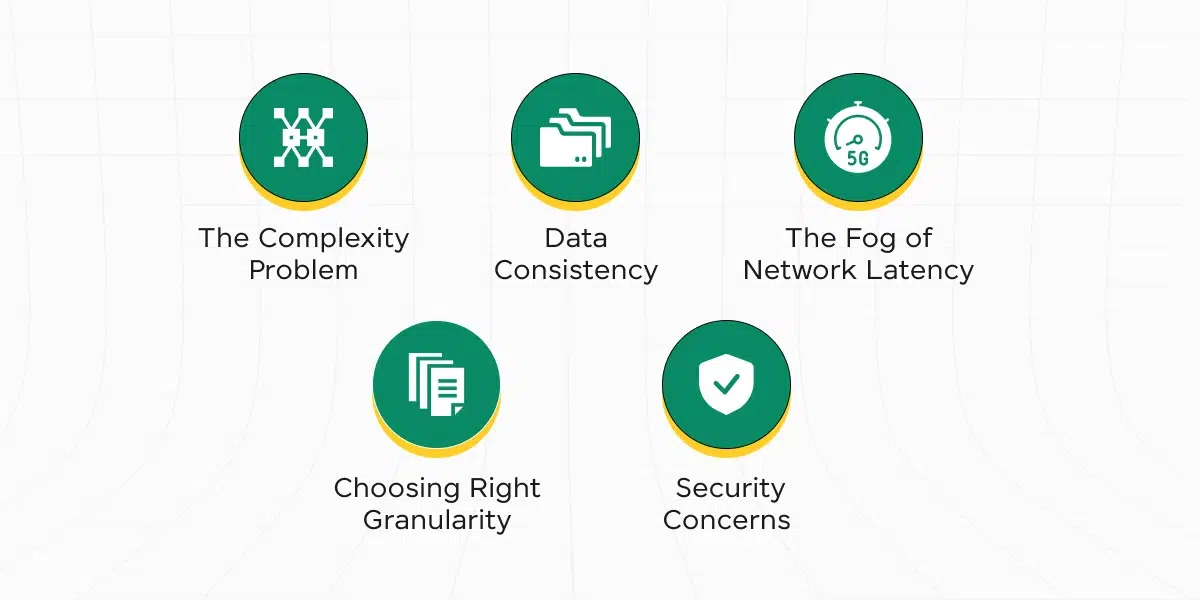
A Comprehensive Guide to Microservices Architecture and Implementation [2024]
Mar 26, 2024 5 Min Read 1523 Views
(Last Updated)
In full-stack development, one of the strongest debates that come from time to time is microservices architecture vs monolithic architecture. While the latter is a traditional architecture, the former is a recent one and it is the one that’s winning hearts right now.
This article is going to be all about the winner of hearts, microservices architecture. You may wonder, why should I learn this? Trust me, it helps a great deal when you are taking up big full-stack projects and you’ll then thank the gods for learning about this right now.
So, let us dig deep into the world of microservices architecture and understand everything about it.
Table of contents
- What Exactly Are Microservices Architecture?
- The Philosophy Behind Microservices Architecture
- Communication: The Lifeline of Microservices Architecture
- Benefits of Adopting Microservices Architecture
- Exploring the Key Components of Microservices Architecture
- Decentralized Data Management
- Independent Deployment
- Technology Diversity
- Domain-Driven Design
- DevOps and Continuous Delivery
- Microservices Choreography
- Implementation Strategies for Microservices Architecture
- Start with a Strong Foundation: Define Your Domain
- Build Resilient Systems: Design for Failure
- Communicate Effectively: Embrace an API-First Approach
- Keep the Momentum: Leverage Continuous Delivery
- Stay Sharp and Informed: Prioritize Monitoring and Observability
- Challenges and Solutions in Microservices Architecture
- The Complexity Problem
- Data Consistency
- The Fog of Network Latency
- Choosing Right Granularity
- Security Concerns
- Conclusion
- FAQs
- Can microservices and monolithic architectures coexist in the same application?
- How do microservices communicate with each other?
- What are the benefits of adopting a domain-driven design (DDD) in microservices architecture?
- What is a service mesh, and why is it important in microservices architecture?
- How do you determine the right size for a microservice?
What Exactly Are Microservices Architecture?

Now to make your understanding of microservices architecture easier, let us take a simple analogy of building blocks, the ones that we use to build toy buildings.
Think of Microservices Architecture as those building blocks for grown-ups in the tech world. In a traditional monolithic architecture, your application is like a huge, pre-assembled toy building.
It’s grand, yes, but what if you only want to change the color of one portion? Suddenly, you’re dismantling everything just to reach that one piece.
Enter microservices architecture. Instead of one giant toy building, you build several smaller structures—each with its purpose. One could be a tower, another a drawbridge, and so on.
Each piece is independent but can connect to form a larger kingdom. This is the essence of microservices architecture: breaking down applications into smaller, manageable, and independently deployable services.
Also Explore: Full Stack Developer Roadmap: A Complete Guide [2024]
The Philosophy Behind Microservices Architecture
Each microservice focuses on doing one thing and doing it well, operating independently but as part of a larger ecosystem. This approach encourages innovation and agility, as changes can be made to a single service without affecting the rest of the application.
Communication: The Lifeline of Microservices Architecture
In a microservices architecture, the communication happens through APIs (Application Programming Interfaces). APIs are like the language services used to talk to each other, ensuring they can work together smoothly to create a cohesive application.
Benefits of Adopting Microservices Architecture
- Scalability: Scaling parts of your application becomes simpler with microservices. You can scale services independently based on demand.
- Flexibility: With a microservices architecture, you can experiment with a single service without risking the entire application.
- Resilience: If one service fails, it doesn’t mean the whole application crashes. The rest of the services can continue to operate.
- Faster Deployment: Since services are deployed independently, updates and improvements can be rolled out much quicker.
Microservices architecture is a powerful approach to building software, offering flexibility, scalability, and resilience. It encourages looking at applications not as monoliths but as collections of smaller, focused services that can evolve independently.
Explore: Top 10 Full-Stack Developer Frameworks in 2024
Before we move to the next section, make sure that you are strong in the full-stack development basics. If not, consider enrolling for a professionally certified online full-stack web development course by a recognized institution that can also offer you an industry-grade certificate that boosts your resume’s outlook.
Exploring the Key Components of Microservices Architecture

Now that you understand the basics of microservices architecture, let us move on to the next step of understanding the key components that makeup microservices architecture.
Let us look into the key components of microservices architecture.
1. Decentralized Data Management
In the world of microservices, every service is like an independent mini-country with its own rules, culture, and, most importantly, its currency (data!).
Decentralized data management means that instead of having one massive database that everyone dips into, each microservice manages its database.
This autonomy prevents data conflicts and ensures that if one service goes down, it doesn’t take the entire data system with it. It’s all about keeping the peace and order in our microservices kingdom.
2. Independent Deployment
Independent deployment in microservices architecture enables each microservice to be updated, fixed, or scaled without waiting for the rest of the application to catch up.
This means we can roll out new features or fixes faster. It’s a game-changer for staying agile and responsive to user needs.
Must Explore: Continuous Integration vs Continuous Deployment in DevOps (A Comprehensive Guide)
3. Technology Diversity
In a microservices architecture, each service can be built using the best technology for its specific job. It’s like having a team where one person is an amazing chef, another is a brilliant mathematician, and yet another is a world-class athlete.
Everyone gets to play to their strengths, making the team incredibly versatile and powerful. This diversity allows your team to experiment and innovate, keeping your application at the cutting edge.
4. Domain-Driven Design
Domain-driven design helps us divide the vast sea of functionality into smaller, manageable islands (domains) and then further into individual microservices.
This approach ensures that each microservice is closely aligned with business goals, making it easier to understand, develop, and maintain. It’s about being smart and strategic in how we organize our microservices adventure.
5. DevOps and Continuous Delivery
Imagine if, every time you made a small change to a puzzle, you could instantly see how it fits into the bigger picture. That’s the magic of DevOps and continuous delivery in the microservices world.
It’s all about building, testing, and releasing software quickly and reliably. This component ensures that updates are smooth sailing and that our application continuously evolves without major disruptions. It keeps the journey exciting and dynamic.
6. Microservices Choreography
In the dance of microservices, choreography is how each service knows its steps and moves in harmony with the others, without a central conductor.
Services communicate through events or messages, leading to a system that’s more flexible and scalable.
Learn More: 6 Essential Prerequisites for Learning AngularJS
Implementation Strategies for Microservices Architecture

So, you’ve got a grasp on the key components of microservices architecture and are probably itching to put them into action, right?
Well, the time is right because we’re about to learn all the implementation strategies for microservices architecture:
1. Start with a Strong Foundation: Define Your Domain
Before diving into the microservices ocean, it’s crucial to know the landscape of your application. Like an architect sketching out the blueprint before building, defining your domain involves identifying the different areas of functionality within your application.
Each area can potentially be a microservice. This step is all about understanding the big picture and then zooming in to see where you can carve out independent services.
2. Build Resilient Systems: Design for Failure
Here’s a truth bomb: in the world of microservices, things will fail. But, fear not! Designing for failure is like packing a lifejacket and flare gun before setting sail so that even if you get stranded in the middle of the ocean, you can survive.
Implement strategies like circuit breakers, which prevent a failure in one service from cascading through your system, and retries it from time to time.
Embracing resilience means you’re prepared for the storm and can navigate through it, keeping your application afloat and moving forward.
3. Communicate Effectively: Embrace an API-First Approach
In the world of microservices architecture, APIs are the common language that ensures all services understand each other, no matter where they are or what they do.
Adopting an API-first approach means that you prioritize the design and documentation of these APIs from the get-go, fostering clear and effective communication between services.
4. Keep the Momentum: Leverage Continuous Delivery
Imagine if you could continuously improve your ship, even while sailing across the globe. That’s the essence of continuous delivery in the microservices world.
By automating the build, test, and deployment processes, you ensure that your application can be updated anytime, with minimal effort and maximum speed. It’s about keeping your application ever-evolving, responsive, and ahead of the competition.
5. Stay Sharp and Informed: Prioritize Monitoring and Observability
Sailing through the microservices seas without a compass or a map? Not a great idea. Monitoring and observability are your navigational tools, providing insights into the health and performance of your services.
They help you detect issues before they become storms, ensuring you can navigate your way through challenges with precision.
Implementing comprehensive logging, monitoring, and tracing ensures you’re never lost at sea, and always aware of your environment and how your application is performing.
Know More: The Ultimate Guide to Real-World Full-Stack Development Applications
Challenges and Solutions in Microservices Architecture

Alright, it is now time to address the thorns in the roses—the challenges of implementing microservices. But fear not! For every problem, there’s a solution to rectify it.
Let’s understand some of the common challenges in the microservices architecture and the solutions to those.
1. The Complexity Problem
Challenge: With great power comes great complexity. Microservices can multiply like rabbits, each with its database, deployment pipeline, and dependencies. Managing this much amount of services is a pain in the butt.
Solution: Embrace tools and practices designed for this complexity. Service meshes like Istio or Linkerd can manage service communication, discovery, and security for you.
Containers and orchestration tools like Kubernetes help manage deployment and scaling. By making use of these tools, you can easily solve the complexity problem.
2. Data Consistency
Challenge: Each microservice managing its data sounds great until you need to keep the data consistent across the world. The challenge is maintaining order on the web when everyone has their idea of the data.
Solution: Implement strategies like the Saga pattern, where a series of local transactions are linked by triggering subsequent steps via events or messages.
3. The Fog of Network Latency
Challenge: In a land where services are constantly chatting, the network becomes a crowded marketplace. This chatter can lead to delays—network latency—which slows down your application’s response time.
Solution: Minimize chattiness by designing efficient communication. Use asynchronous messaging or event-driven architectures to allow services to communicate without waiting for responses.
4. Choosing Right Granularity
Challenge: Deciding the size and scope of each microservice can feel like choosing the right outfit. Too big, and you lose flexibility. Too small, and you’re tightened by complexity.
Solution: Strike a balance by aligning services with business capabilities or domain boundaries. It’s a bit like tailoring your outfit so it’s just right—not too heavy, but comfortable enough.
This approach ensures services are cohesive, manageable, and aligned with business goals.
5. Security Concerns
Challenge: With so many independent services, securing the microservices architecture becomes more complex. Each service is a gate that might be breached.
Solution: Implement strong, consistent security practices across all services. Use identity and access management, secure service-to-service communication, and regular audits.
To make the most out of microservices architecture, you need to be aware of all these challenges and know about the potential solutions to them.
Also Read: Top 10 Tools Every Full-Stack Developer Should Master in 2024
Kickstart your full-stack development journey by enrolling in GUVI’s certified Full-stack development course that not only teaches you the basics but also gives you practical experience through real-life full-stack development projects
Conclusion
In conclusion, the world of microservices architecture is so vast but we’ve managed to cover its core concepts, key components, strategic implementation practices, and challenges with tailored solutions.
This architectural style empowers organizations to build scalable, resilient, and flexible applications. Despite the complexities and challenges encountered, the strategies and tools available ensure that microservices architecture remains a formidable foundation for building modern software systems, that pave the way for the new technological era.
Also Read: Difference Between Software Developer vs Full Stack Developer
FAQs
Can microservices and monolithic architectures coexist in the same application?
Yes, it’s possible to have a hybrid approach where certain parts of the application are built using microservices while others remain monolithic. This can be part of a gradual transition to a fully microservices-based architecture.
How do microservices communicate with each other?
Microservices communicate through well-defined APIs, usually over HTTP/HTTPS protocols. They can use synchronous protocols like REST or asynchronous messaging for communication.
What are the benefits of adopting a domain-driven design (DDD) in microservices architecture?
DDD helps in structuring microservices around the business domain, leading to services that are more cohesive, understandable, and aligned with business objectives, enhancing the overall design and functionality of the system.
What is a service mesh, and why is it important in microservices architecture?
A service mesh is an infrastructure layer that facilitates service-to-service communications, ensuring reliable delivery, security, and observability. It’s crucial for managing complex microservices interactions and maintaining system health.
How do you determine the right size for a microservice?
The right size is determined by aligning the service with a single, cohesive business function or domain, ensuring it is small enough to be managed by a small team but large enough to justify its independence.
































Did you enjoy this article?